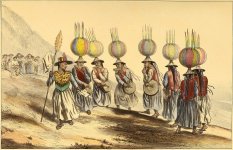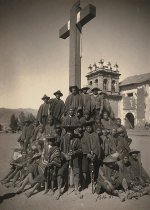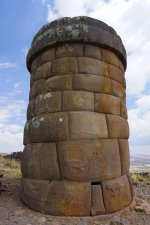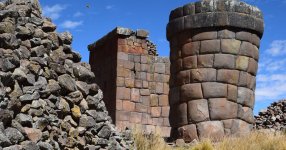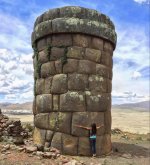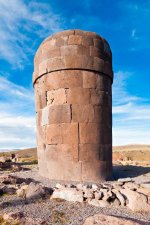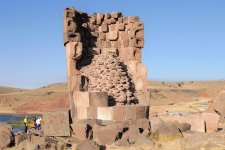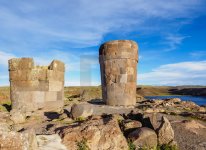This is just a tribute to some fascinating craftsmanship, for I doubt we will ever be allowed to know who built these structures. Perhaps, it's not the craftsmanship itself, or the stone working technique used, that can't cease to amaze me. It's the fact that we do not remember this technique that I find the most fascinating.

I do understand that other places like Sacsayhuamán, Pumacocha, Tambomachay, etc. have structures built using the same technique. Yet, there is something about these chullpa towers that I cannot put a finger on.

Chullpa Towers & Aymara PeopleA chullpa is an ancient Aymara funerary tower originally constructed for a noble person or noble family. Chullpas are found across the Altiplano in Peru and Bolivia. The tallest are about 12 metres (39 ft) high.
Chullpa towers above лоок a bit more "hi-tech" than these towers below.


KD: It appears that most of these towers were built using artificially produced stones. In my current opinion, some pliable composite cement-like mass was still soft when positioned in place, and that's it. I do not think there is anything tremendously complicated in this technique. It had to be as easy as shaping a plaster equivalent of the same. It is pretty obvious that for whatever reason we are forced to consider the stones to be natural.
It's somewhat doubtful, that the Aymara people pictured in the above photographs are the same Aymara people these towers were allegedly built by. As it stands, our current scientific community is great at making up names. Who knows what the below individuals called themselves when they were alive?
By the way, the skulls of the below type, are also being attributed to Aymaras.
I am not gonna pretend that I know what we have going on here. Once again, the narrative appears to be full of baloney.
I do understand that other places like Sacsayhuamán, Pumacocha, Tambomachay, etc. have structures built using the same technique. Yet, there is something about these chullpa towers that I cannot put a finger on.
- Imho, these towers are a huge overkill as far as the intended purpose goes, unless... there is something we do not know.
Chullpa Towers & Aymara People
- Their ancestors lived in the region for many centuries before becoming a subject people of the Inca in the late 15th or early 16th century, and later of the Spanish in the 16th century.
- With the Spanish American Wars of Independence (1810–25), the Aymaras became subjects of the new nations of Bolivia and Peru.
- After the War of the Pacific (1879–83), Chile annexed territory with Aymara population.
- The Lupaca people were one of the divisions of the ancestral Aymaras.
- This is an original 1875 black and white wood engraving of an Aymara Indian Mummy at a Chullpa located in the Sillustani, a pre-Incan burial ground near Puno, Peru.
- Ten Corpses in Chullpa, South America, c. 1860
- Corpses in each tomb were typically placed in a fetal position along with some of their belongings, including clothing and common equipment.
- In virtually all cases, the only opening to the tomb faces the rising sun in the east.
- The construction of the chullpa varied with ethnic group: in general, those of the north Altiplano are circular and constructed with stone, while those of the south are rectangular and constructed with adobe.
- Some are unadorned, while others have intricate carvings.
- At Sillustani, many of the chullpas have lizards, which were considered a symbol of life because they could regenerate their tails, carved into the stone.
- It is possible that chullpas were also used by the Inca following their conquest of the Aymara.
- Very similar stone constructions on Easter Island known as tupa have sometimes been suspected to be closely related to chullpas.
Chullpa towers above лоок a bit more "hi-tech" than these towers below.
KD: It appears that most of these towers were built using artificially produced stones. In my current opinion, some pliable composite cement-like mass was still soft when positioned in place, and that's it. I do not think there is anything tremendously complicated in this technique. It had to be as easy as shaping a plaster equivalent of the same. It is pretty obvious that for whatever reason we are forced to consider the stones to be natural.
- Some of the stones are humongous. I wonder why..?
It's somewhat doubtful, that the Aymara people pictured in the above photographs are the same Aymara people these towers were allegedly built by. As it stands, our current scientific community is great at making up names. Who knows what the below individuals called themselves when they were alive?
- Here come the elongated skulls.
By the way, the skulls of the below type, are also being attributed to Aymaras.
I am not gonna pretend that I know what we have going on here. Once again, the narrative appears to be full of baloney.
- Who and what were these humanoids?
- What was the intended purpose of these towers?
- Were they originally designed to be burial chambers?


